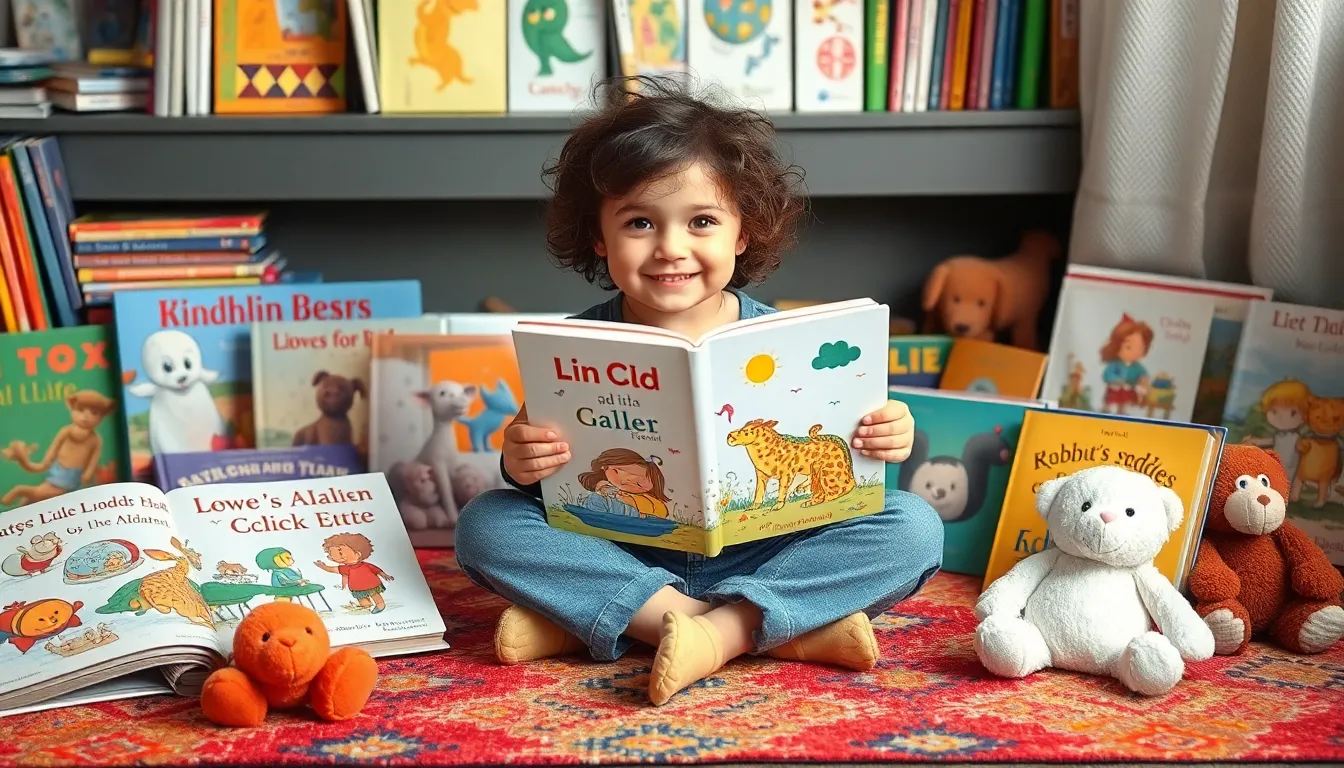Finding the perfect children’s book can feel like searching for a unicorn in a haystack. With so many options, it’s easy to get lost in a sea of colorful covers and catchy titles. But fear not! The right book can spark imagination, ignite a love for reading, and keep kids entertained for hours—while parents enjoy a much-needed coffee break.
Table of Contents
ToggleImportance Of Reading For Children
Reading plays a crucial role in a child’s development. It enhances vocabulary and language skills, allowing children to express themselves more clearly. Engaging with various narratives sparks imagination, encouraging creative thinking.
Books provide a gateway to different cultures, experiences, and ideas. Exposure to diverse viewpoints cultivates empathy, helping children relate to others. Studies show that early readers often perform better academically, establishing a strong foundation for future learning.
Regular reading strengthens concentration and focus. Children develop the ability to pay attention to details, which translates into their academic performance. Moreover, reading together fosters bonding time between parents and children, promoting shared experiences.
Storytelling can spark discussions on complex topics. By addressing issues such as friendship, honesty, and perseverance, children learn valuable life lessons. Research indicates that children who engage with literature develop critical thinking skills, enabling them to analyze and interpret information effectively.
Utilizing age-appropriate and engaging books makes reading enjoyable. By instilling a love for reading early on, parents cultivate lifelong habits that enhance knowledge and imagination. Ultimately, regular reading sessions contribute to a child’s overall growth, shaping them into well-rounded individuals.
Top Children’s Book Recommendations

Engaging children’s books nurture a love for reading and contribute significantly to childhood development. Selecting the right titles enhances vocabulary and sparks imagination.
Picture Books
Picture books captivate young readers with vibrant illustrations and simple narratives. These stories often cover essential themes like friendship, kindness, and adventure. Titles like “The Very Hungry Caterpillar” by Eric Carle and “Where the Wild Things Are” by Maurice Sendak stand out in this category. Each book helps children understand emotions and experiences, fostering empathy from an early age. Parents can share these books during storytime to create lasting memories.
Early Readers
Early readers bridge the gap between picture books and chapter books. They feature simple sentences and larger print, making it easier for young readers to grasp concepts. “Frog and Toad Are Friends” by Arnold Lobel and “Green Eggs and Ham” by Dr. Seuss offer engaging stories paired with humor. These books build confidence in reading while reinforcing key concepts like phonetics and vocabulary. Parents can encourage their children to explore these titles independently, promoting reading as a joyful experience.
Middle Grade Novels
Middle grade novels cater to ages 8-12 with deeper narratives and more complex characters. Titles like “Harry Potter and the Sorcerer’s Stone” by J.K. Rowling and “The Chronicles of Narnia” by C.S. Lewis invite readers into magical worlds. Themes often include friendship, courage, and self-discovery, resonating with young readers. These stories enhance critical thinking skills and stimulate discussions on life’s important questions. Parents might find joy in exploring these chapters alongside their children, making reading a shared adventure.
Tips For Choosing The Right Book
Selecting the right children’s book requires careful consideration. Key factors include age appropriateness and the child’s interests.
Age Appropriateness
Choosing age-appropriate books is essential for engagement and comprehension. It ensures that stories match the child’s developmental stage. Picture books work well for toddlers and preschoolers, offering visual allure and straightforward themes. Early readers should feature simple sentences and relatable characters to build confidence. Middle grade novels cater to ages 8-12, presenting richer narratives and deeper themes. Pay attention to reading level indicators and guidelines provided by publishers to find suitable options.
Interests And Preferences
Understanding a child’s interests enhances the likelihood of picking a favorite book. Topics like animals, adventures, or fantasy may resonate differently based on individual tastes. Engaging with the child about their preferred stories can narrow down choices. Explore varying genres, such as mystery, science fiction, or historical fiction, to discover what excites them most. Selecting books that match their hobbies can spark enthusiasm for reading and encourage a lifelong love of literature.
Benefits Of Diverse Literature
Diverse literature offers numerous benefits for children. Exposure to different cultures and perspectives fosters empathy. By engaging with varied characters and stories, young readers develop a broader understanding of the world. Diverse books cultivate critical thinking skills, allowing children to analyze situations and characters from multiple viewpoints.
Cultural representation in literature enhances children’s self-esteem. When children see characters who look like them, it reinforces their identity and validates their experiences. This representation encourages a sense of belonging and acceptance in the literary world.
Improved vocabulary and language skills result from reading diverse literature. Unique storytelling styles and linguistic patterns introduce children to new words and phrases. As they encounter various dialects and cultural expressions, their language comprehension expands.
Discussion of societal issues also benefits from diverse literature. Children confront complex topics such as race, gender, and social justice, prompting thoughtful conversations. These discussions educate and empower young readers to think critically about real-world challenges.
Moreover, diverse books inspire creativity and imagination. By exploring different narratives, children learn that stories can take many forms. This realization encourages them to craft their own unique stories, fueling their passion for writing and storytelling.
Adding diverse literature to a child’s reading list enhances overall academic performance. Exposure to a variety of genres and themes sparks interest in reading and learning. As students engage with diverse texts, they develop better analytical skills, which can improve comprehension.
Through diverse literature, children not only enjoy captivating stories but also grow into empathetic, informed individuals. Prioritizing such literature in a child’s reading journey positively influences their emotional and intellectual development.
Selecting the right children’s book can transform reading into an enriching experience. By exploring age-appropriate titles and considering a child’s interests, parents can ignite a passion for literature that lasts a lifetime. Diverse literature not only broadens horizons but also cultivates empathy and critical thinking.
Encouraging regular reading habits fosters a strong bond between parents and children while enhancing language skills and creativity. With the right choices, parents can turn storytime into a delightful adventure that nurtures both the mind and heart. Embracing these recommendations will help children thrive through the magic of books.




